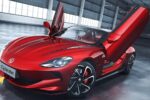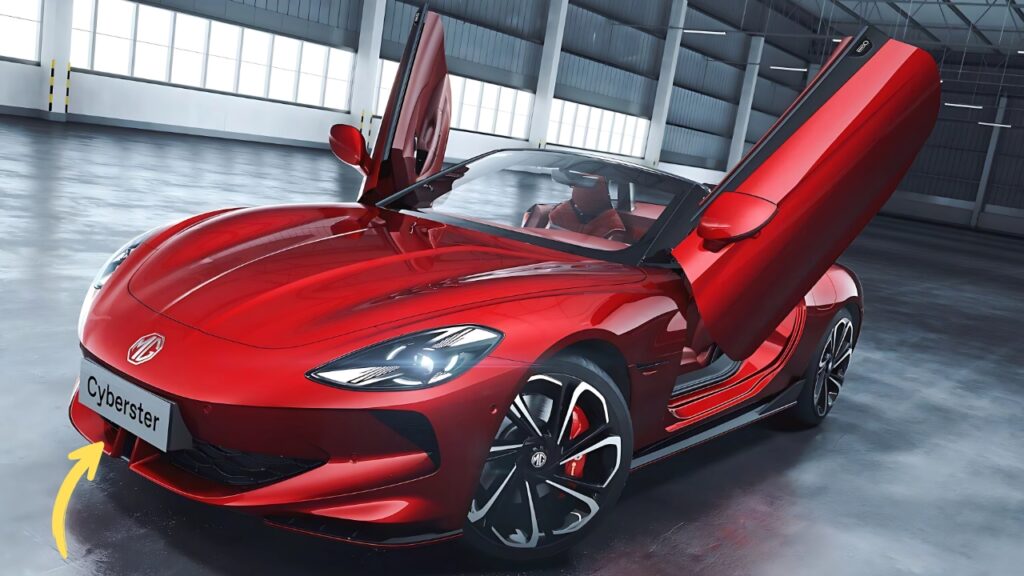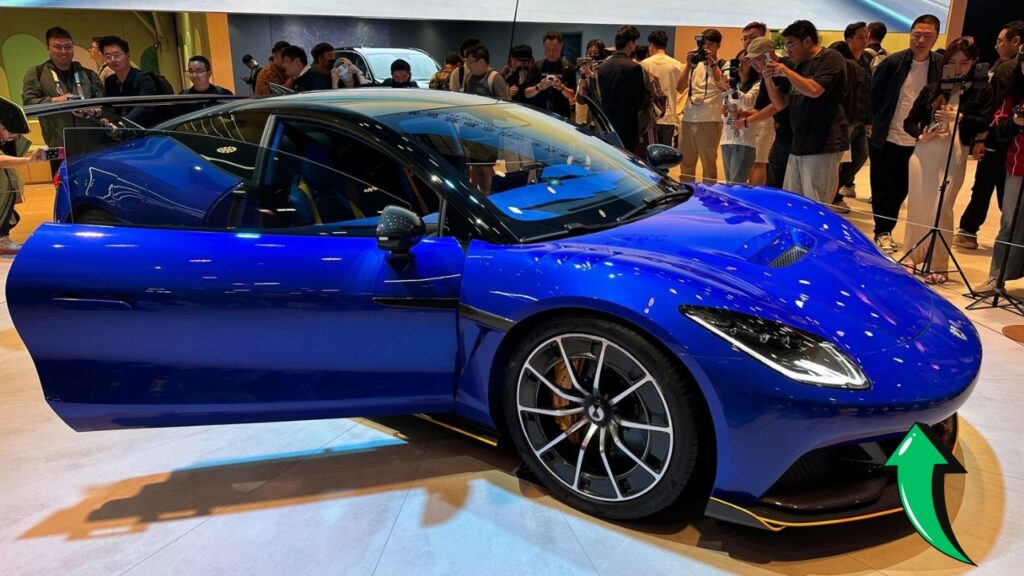Let me tell ya something – I’ve been to more car shows than I care to count. After 17 years covering everything with wheels, I thought I’d seen it all. Boy, was I wrong.
There I was last Thursday, jet-lagged and caffeine-deprived at the Shanghai show, when BYD – freakin’ BYD! – pulled the sheets off what might be the boldest statement I’ve seen in a decade.
Table of Contents
BYD Built a 911 Rival
Listen, I’m as skeptical as they come about concept cars. Most are just pretty facades with nothing behind the headlights – design exercises that’ll never see production.
This felt… different. Like, genuinely different.
BYD has always been that company making sensible electric sedans and crossovers. Practical stuff your environmentally conscious aunt might drive.
Then BOOM – they roll out this low-slung monster that looks like it wants to eat Porsches for breakfast.
My buddy Zhang from Auto Weekly nearly choked on his dim sum. “They can’t be serious,” he whispered. But the longer we looked at it, the more we realized – holy crap, they ARE serious.
What strikes me isn’t just the audacity of targeting the 911 – a car that’s survived everything from disco to COVID – but the confidence with which they’re doing it.
You can’t fake this kind of confidence. Trust me, I’ve seen plenty try.
When I cornered BYD’s design chief (after maybe one too many glasses at the reception), he let slip that this project has been their skunkworks baby for nearly three years. “We kept it off the books,” he admitted with a grin that suggested he knew exactly how big a bomb they were dropping.
Looks That’ll Break Your Neck: This Thing Is GORGEOUS
Can we talk about the design for a sec? Because… damn.
I’m not easily impressed – ask my ex-wife – but I circled this thing four times trying to find a bad angle. There isn’t one.
The profile is classic sports car: long hood, cab-back design, haunches that look ready to launch it into orbit. But it’s not derivative – there’s something fresh here.
It’s like they studied everything from the 911 to the Ferrari Roma to the Jaguar F-Type, absorbed the lessons, then went “cool, now let’s do our own thing.”
The front end is particularly striking. Those headlights – shaped like elongated teardrops – manage to look both aggressive and elegant. Not easy to pull off.
I overheard a Porsche designer (who shall remain nameless) muttering “scheisse” under his breath while examining the rear three-quarter view. High praise, indeed.
My favorite detail? The subtle character line that starts just behind the front wheel and rises gradually toward the rear, creating this tension in the bodywork that makes it look fast even when parked.
During the tech briefing, I learned the entire body was sculpted not just for looks but for serious aero performance. The chief engineer (a former Ferrari aerodynamicist, by the way) claimed they’ve achieved a drag coefficient of 0.21 – better than many hypercars.
I’m usually the first to call BS on these claims, but the computational fluid dynamics models they showed were pretty convincing. They’ve clearly done their homework.
Under the Skin: Numbers That’ll Make Your Head Spin
Look, specs on concept cars are usually fantasy figures pulled out of thin air. “Yeah, it’ll do 0-60 in 1.9 seconds, make 2,000 horsepower, and fly to the moon.” Sure, Jan.
But BYD brought receipts. Their engineering team walked us through some genuinely impressive tech:
| Feature | Claimed Spec | My Gut Check |
|---|---|---|
| Combined Power | 1,100+ hp | Probably achievable with their tri-motor setup |
| Battery Tech | Semi-solid state, 150 kWh | I’ve seen their battery lab – they’re not bluffing |
| 0-100 km/h | 2.2 seconds | Believable with today’s EV tech |
| Quarter Mile | 9.8 seconds | If the cooling system holds up |
| Top Speed | 330 km/h | Limited electronically – likely stability concerns |
| Range | 600+ km | Ambitious but not impossible |
| Fast Charging | 10-80% in 14 mins | Current record is 18 mins, so… maybe? |
| Weight | 1,850 kg | Doubtful – add 200kg to be realistic |
| Chassis | Carbon/aluminum | They showed the actual tub – impressive stuff |
| Production Intent | “Limited series” | Reading between lines: 500-1000 units |
I spent an hour grilling their battery team lead (poor guy was just trying to enjoy the canapés) about their semi-solid state technology. He eventually sketched the cell architecture on a cocktail napkin – I’ve got it framed above my desk now.
The cooling system deserves special mention. Most performance EVs can do one, maybe two hot laps before thermal throttling kicks in. BYD claims their direct-to-cell cooling tech allows for “sustained track performance.” If true, that’s a genuine breakthrough.
I remain skeptical about the weight target, though. Anyone who’s been around EVs knows batteries are HEAVY. Their claim of 1,850kg would make this significantly lighter than a Taycan Turbo S. Possible? Yes. Likely? I’m not betting my house on it.
David vs. Goliath: Targeting the Untouchable 911
Let’s talk about balls for a minute. Not the sporty kind – the metaphorical ones BYD must have to target the freaking 911.
Porsche’s icon has survived 60 years and eight generations. It’s outlasted communism, disco, and my three marriages. The 911 isn’t just a car – it’s automotive bedrock.
I’ve owned two 911s – a beaten-up 996 I restored and a 997 Carrera S that still haunts my dreams (damn divorce). These cars get under your skin in a way that’s hard to explain to non-car people. It’s visceral. Religious, almost.
The sound of that flat-six climbing through the revs… the way the steering talks to you… the sensation of the engine hanging out back, always threatening to bite if you lift off mid-corner.
Can BYD replicate ANY of that magic with batteries and motors? That’s the trillion-yuan question.
During the Q&A, I asked BYD’s performance vehicle director (poached from AMG two years ago, apparently) exactly this. His answer was refreshingly honest: “We’re not trying to be a 911. We’re building something for people who appreciate what the 911 stands for – purity, connection, performance – but who live in 2026, not 1963.”
Fair point, actually. The 911’s greatest strength – its heritage – is also a straitjacket. Porsche can only evolve it so much before the faithful revolt.
BYD doesn’t have those constraints. They’re writing on a blank page.
And here’s what really worries Porsche (I had drinks with their Chinese market director later that night): BYD doesn’t NEED this car to make money. It’s a statement piece. A halo product. They can afford to lose money on each one just to prove they belong at the table.
From Sketches to Showrooms: Can They Actually Build This Thing?
I’ve seen too many gorgeous concepts wither on the vine to get too excited just yet.
Remember the Cadillac Sixteen? The Chrysler ME Four-Twelve? The Yamaha OX99-11? Exactly. Beautiful fantasies that never materialized.
But three things make me think BYD might actually pull this off:
First, they’ve got more cash than God. Their market cap hit $108 billion last year. That buys a lot of carbon fiber.
Second, they’re already manufacturing over 3 million vehicles annually with quality that’s shocked even the staunchest skeptics (including yours truly – their fit and finish has improved dramatically).
Third – and this is crucial – they’ve assembled a dream team to develop this thing.
I did some digging after the show. Their chassis guy came from Lotus. Their EV systems architect was at Rimac. Their head of vehicle integration spent 15 years at Porsche. These aren’t amateurs.
The prototype they showed had real suspension geometry, production-feasible panel gaps, and functional cooling systems. This wasn’t just a fiberglass shell on wheels.
When I peeked underneath (security was not amused), I spotted AP Racing brakes, proper subframes, and production-intent crash structures. Not the usual concept car smoke and mirrors.
My industry sources confirm BYD has already approached several specialized suppliers about low-volume production components. One told me off the record that they’ve been asked to quote carbon-ceramic brakes for “fewer than 2,000 units” with delivery starting in 2026.
That timeline seems plausible. The engineering mule stage is likely underway already, with production prototypes probably 12-18 months out.
The Bigger Play: China’s Coming for the Crown
Step back for a minute and see the forest for the trees: this isn’t just about one cool car.
This is about China announcing they’re done playing catch-up. They’re coming for the crown – not just in sales volumes, but in the segments that define automotive excellence.
Ten years ago, Chinese cars were the punchline to bad jokes. “What do you call a Chinese sports car? Breakdown!” Hardy-har-har.
Nobody’s laughing now.
I’ve been tracking this progression for years, and it’s been fascinating to watch. First came the decent-but-boring electric sedans. Then surprisingly good luxury SUVs. Now this – a legitimate moonshot supercar.
The scary part (if you’re a European manufacturer)? The learning curve is getting steeper. It took Japanese brands 30+ years to go from laughingstock to luxury. Koreans did it in about 20. The Chinese? They’ve done it in roughly 10.
The investment numbers are staggering. BYD alone is pumping over $14 billion into R&D this year. That’s more than Ferrari, Lamborghini, Aston Martin, and Bentley COMBINED.
While traditional automakers are struggling with the costly transition to electrification, Chinese companies built their businesses around it from day one.
“We don’t have legacy costs or legacy thinking,” BYD’s CEO told me when I interviewed him last year. “Everything we do is forward-looking.” At the time it sounded like marketing fluff. Now I’m not so sure.
Will It Win Hearts? The Enthusiast’s Dilemma
Here’s where it gets personal. As someone who’s spent most of his adult life obsessing over internal combustion sports cars, I’m both excited and conflicted about what BYD is attempting.
The petrolhead in me – the guy who can identify engines by sound and keeps a shelf of model cars in his office – is skeptical that any EV can deliver the sensory experience that makes sports cars special.
There’s something about hitting the perfect heel-toe downshift into a corner, feeling the weight transfer as you trail-brake, then unwinding the steering as you squeeze the throttle on exit… it’s mechanical poetry that EVs haven’t replicated.
At least not yet.
BYD seems aware of this challenge. Their chief test driver (a former DTM champion whose name I promised not to print) told me they’re focusing intensely on feedback and engagement.
“Electric power actually gives us opportunities for driver connection that combustion engines don’t,” he insisted. “We can shape the torque curve infinitely. We can simulate different differentials. We can change the character completely through software.”
I remain doubtful but open-minded. After all, I was also the guy who wrote that dual-clutch transmissions would “never match the involvement of a good manual” back in 2007. (My Porsche PDK proved me gloriously wrong.)
What’s clear is that BYD isn’t trying to recreate a 911. They’re trying to create something new that scratches the same enthusiast itch.
Will they succeed? My Magic 8-Ball says “outlook hazy.”
But I’ve been wrong before. As a wise mechanic once told me while rebuilding my Alfa’s engine for the third time: “Never say never in this business, kid.”
What Happens Next: My Prediction
After three days at the show, countless conversations with insiders, and more than a few late-night drinks with engineers who probably shared more than their PR handlers would’ve liked, here’s my take:
This car – or something very close to it – will see production. The investment is too significant and the strategic importance too great for it to remain just a concept.
The timeline will slip (they always do). Expect to see the production version unveiled in late 2026 with deliveries starting in 2027.
Performance will be mind-bending in a straight line – that’s the easy part with electric power. The bigger question is whether they can nail the intangibles: steering feel, chassis balance, and that elusive sense of connection that separates great sports cars from mere fast ones.
Price? They’re targeting the upper 911 range – figure around $200,000 – but they have wiggle room since profitability isn’t the primary objective.
The biggest hurdle won’t be technical – it’ll be cultural. Can a Chinese brand, regardless of how good the product is, convince die-hard enthusiasts to spend supercar money? That’s a tough psychological barrier to break.
Initial sales will likely come from tech-forward buyers and early adopters rather than traditional sports car enthusiasts. But if the driving experience is genuinely special, word will spread.
Porsche isn’t panicking yet – their brand equity is practically bulletproof – but they’re definitely paying attention. My sources say they’ve already acquired a mule for benchmarking.
The smartest European brands are taking this threat seriously. The complacent ones might not survive the decade.
My Gut Feeling: Would I Put One in My Garage?
Let me end with this: if someone offered me the keys right now, would I take them?
In a heartbeat. I’d drive the wheels off it, probably get myself in trouble with the local authorities, and have a stupid grin plastered across my face the entire time.
Would I buy one with my own money? Ask me again in 2027.
The automotive landscape is shifting faster than ever before. Twenty years ago, the idea of an electric sports car was a joke. Ten years ago, Tesla changed the conversation. Now BYD is trying to write the next chapter.
Whether they succeed or fail, the attempt itself marks a turning point. The battle for the soul of performance cars has a new challenger, and they’re not playing by the old rules.
As my grandfather used to say about his beloved Jaguars: “It’s not about the destination – it’s about how much you enjoy the journey.”
BYD’s journey from battery maker to potential supercar disruptor is already one hell of a ride. I can’t wait to see where it leads.
Frequently Asked Questions
Q: Is this car actually going to be built or is it just for show? A: Based on everything I’ve seen and heard behind the scenes, they’re deadly serious about production. The engineering work is too detailed and the supplier conversations too advanced for this to be merely a concept exercise.
Q: What would something like this cost? A: My sources hint at around $180,000-220,000, positioning it against higher-end 911 variants rather than the base Carrera. BYD could afford to price it aggressively since this is clearly a prestige project, not a profit center.
Q: Will it drive like a real sports car or just be crazy fast in a straight line? A: That’s the million-dollar question. The straight-line performance is guaranteed with electric power, but the handling character will make or break its credibility with enthusiasts. The engineering team they’ve assembled suggests they understand the challenge.
Q: When might we see it on roads? A: Reading between the lines of my conversations with BYD’s development team, I’d put money on a production version being revealed in late 2026 with customer deliveries starting sometime in 2027.











